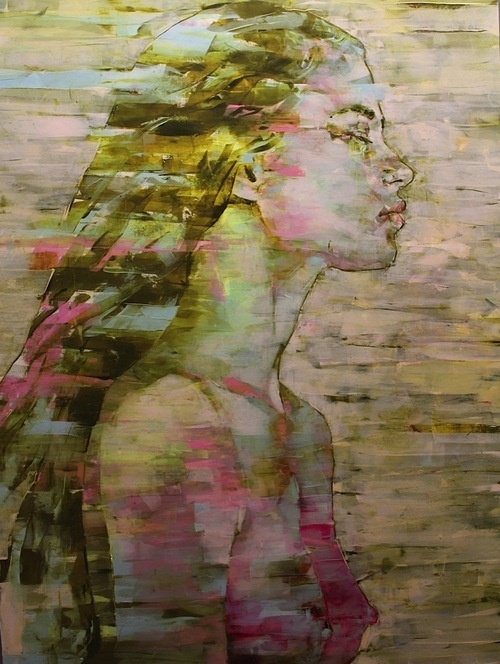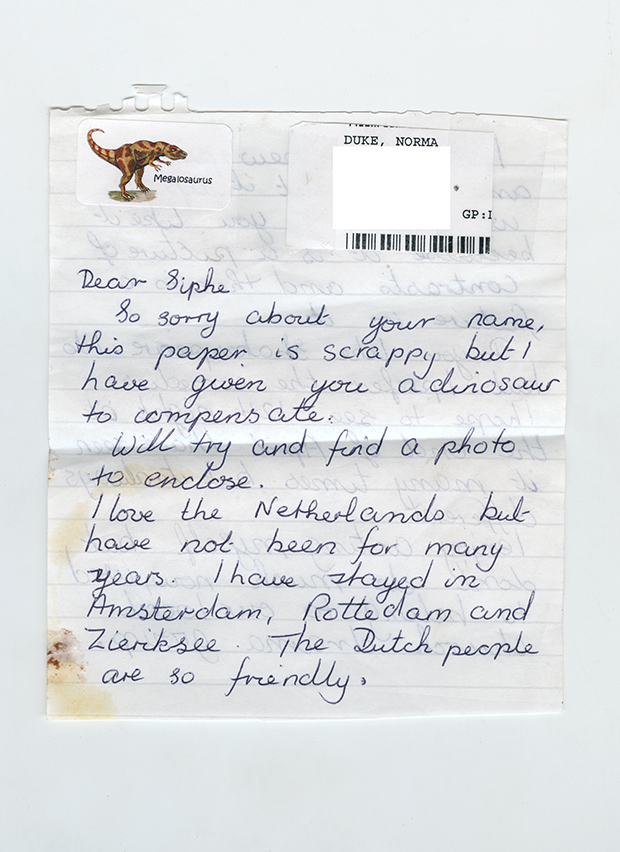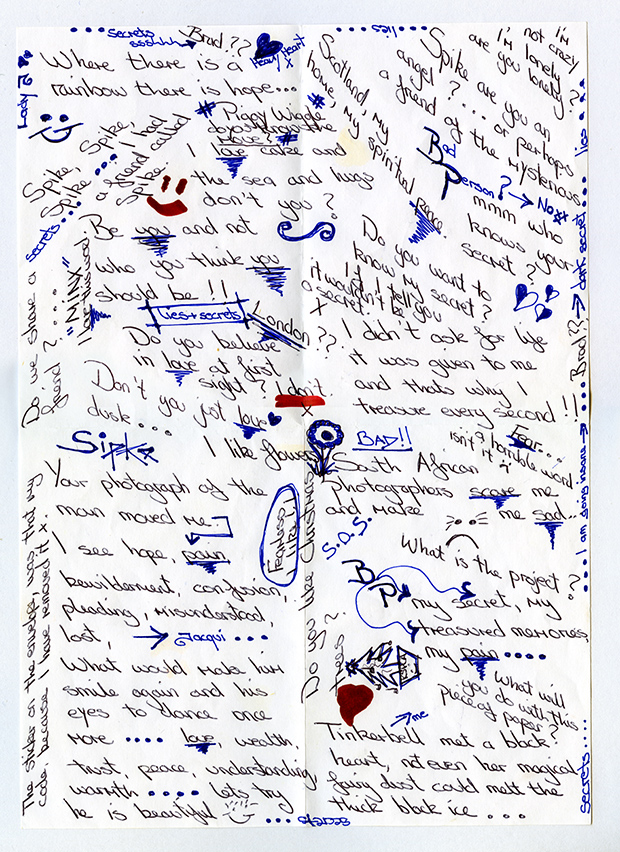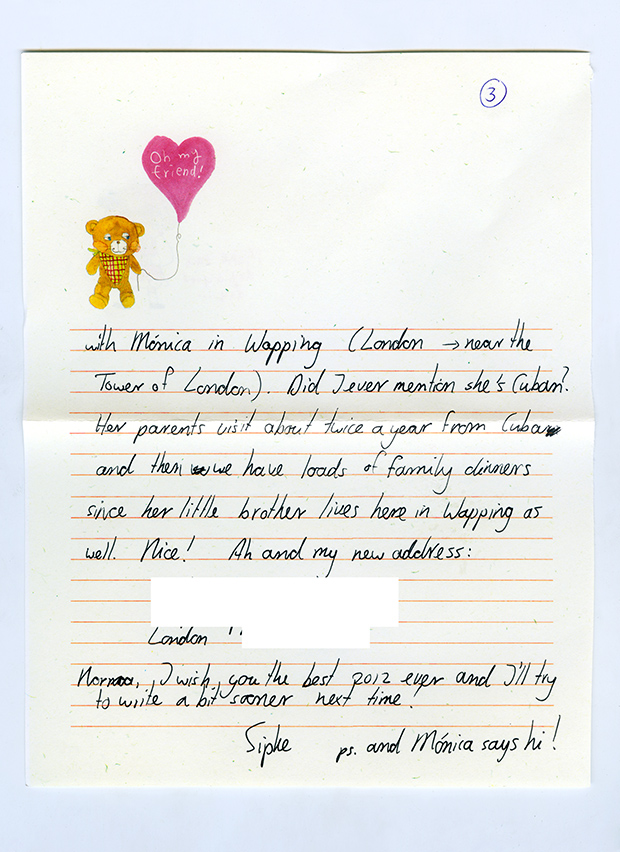Feb 14, 2013 | painting
Marco Grassi is an Italian artist working in Milan, and his artworks are all casual colorful interpretations of people – usually sexy women. Some of his styles are looser than others, letting the color scribble across or swath wherever they please. His lines are always perfect though, each knowing exactly where that body part would emerge from the sometimes empty, sometimes patterned background.
Each of these women have so much personality behind their simply drawn expressions, but it’s always some form of happiness: peace, excitement, and especially “come hither.”
The piece below was my absolute favorite: the girl closes her eyes with so much serenity, like she’s finally free of a what used to be an excruciatingly heavy burden. Her hair shines, picking up reflections of gold and yellow, and the horizontal wooden striped pattern covers her skin in purples and pinks, like colors coming in the wind. A beautiful trusting face beneath a reflective color filter, applied by the artist’s hand to accentuate parts of her face and body in purple and gold.

See more of Marco Grassi’s work on his website here.
Feb 13, 2013 | books, interviews
Sipke Visser grew up in the northern Netherlands, but currently resides in Wapping, London. All of his works involve strangers, and this time connecting strangers – people who otherwise would have no knowledge of the other’s existence. Sipke “aims to photograph those intimate moments when people are immersed in themselves or with each other,” and for this project Return to Sender, Sipke sent those photographs to hundreds of random addresses across the UK. Included with these photographs was a stamped and addressed return envelope along with a handwritten letter asking for a very open-ended response – either to the photograph, about your day, a random thought, anything really.
Return to Sender was recently published as a 480 page book, a careful recording of the correspondences that came from each of the 500 letters that Sipke sent over the course of two and a half years. He found the addresses at random on GoogleMaps, sending a few of the letters to the US as well. A random human response survey that allows for any sort of reply, using what’s almost now an archaic form of communication – although it is the only one that still remains somewhat physical.
This post contains images of the photographs sent and letters received, courtesy of the artist.

Did you ever have a pen pal when you were little? Do you often used the postal system to communicate with people, even if it’s just for the novelty of it?
I must have at some point but to be honest I don’t remember at all. If my penpal from back then remembers, please let me know!
When did the idea for Return to Sender strike you? Was it always intended to turn into a book?
It was in the autumn of 2008 and I was having take away dinner with three friends in yet another friends home in Amsterdam. One of them had been a postman for a while which we were talking about and then suddenly it struck me that it would be fun sending images to random strangers. The foreword in the book is written by one of these friends, the one who used to be a postman.

Which responses did you like the most? How often did the responses mention or relate to the photograph you’d sent them?
The one that stands out most is Norma since we kept on writing. There are many letters written by both of us to each other on the book. She writes about everything that happens to her. About her children, her grandchildren, her mum (who passed away at some point). I
write about what I do, my love life, London, etc. There is a guy called Donald who sent me pictures of himself and his sun. There is a beautiful one of a lady whose mother in law is not doing very well but who is very religious. The image she received happens to be religious and she writes how special that was for her. There is an A4 full of doodles by someone anonymous. And also some very rude or aggressive ones that are quite funny once you get past the rudeness – although I was a bit offended when receiving them.
Some people do talk about the image they received, but many others don’t.
What do you hope the readers of Return to Sender take away from both the book and the project as a whole?
For me it was about many things but I think the main thing is the idea that complete strangers receives a letter and a photo in the post without expecting it at all. And I’m so curious to where they ended up and I love receiving post and finding out. I think I just hope people will enjoy reading the responses and perhaps like the pictures. It’s a book you can open up on any page and since it’s a lot of pages you might find something new many times.

What other sorts of projects have you done previously and what do you think you’ll do next?
A few years ago I was very busy with work (I make most of my living as a retoucher) and barely had time to shoot so I thought it would be a good idea to invite people to my place to photograph them for an hour or so. I put an ad out on a website called Gumtree which I think is similar to Craigs List. Over 30 people visited me in about a years time and I took their portraits. The images and some text are on my website. I also once rented an empty room for a month and invited strangers over for an hour. All that was in the room was coffee, tea, an old 35mm camera with one lens and me. The light in the room was terrible and the pictures not great but it was a great way of spending time with a subject and a camera and nothing else. And I’ve got a great number of projects in my head that I want to do now, but I’m not saying what yet. The best way to stay up to date is to visit www.asortofdiary.com

{About A Sort of Diary: the website Sipke started when he moved to London from Amsterdam in 2005 to start a life in photography. A Sort of Diary is a visual outlet for what has kept him busy over the years. Not quite a blog, not quite a website, more a …. sort of diary. His eye for a great off-beat moment, combined with humorous comments and observations on the friends, family and strangers (not to mention animals) in the photos leave you feeling as though you’ve come to know him personally.}


For more of Sipke’s work, see his website.
Feb 5, 2013 | painting, sculpture
I’ve always found the whole “paragone” thing so interesting. Paragone is the Italian Renaissance word for the competition between different media, often referred to as the competition between the arts. In the contemporary art world the idea doesn’t really translate since media are often crossed over and blended, either in one image on a computer or physically in one place. Most artists today refuse to classify as themselves as a “painter” or a “sculptor,” but I really feel like the limitations of traditional media force artists to push themselves and their craft in a way that doesn’t happen often anymore.
When artists broaden their scope to include anything and everything – concepts from every range of the human experience along with every kind of media available – there isn’t the obsessive, hyper-attuned focus that’s needed to create something powerful. All good works have to have something obsessive about them, whether it’s one idea or one media. Before photography that obsessive bit usually involved an incredible faithfulness to reality.
 |
| Triple Portrait of Cardinal de Richelieu by Philippe de Champaigne and studio, c. 1642 |
During the Italian Renaissance when this word was floated across the lofty circles of artists and patrons, that competition of the paragone was completely focused on the work’s faithfulness to reality. These patrons were paying scudi by the thousand so that us, the people who live thousands of years later, could still remember what they looked like.
The portrait bust below was completed after Bernini’s model of Cardinal Richelieu, a portrait the Cardinal didn’t sit for. Bernini created the sculpture solely from examining the painting of the Cardinal above, sent to him and completed by Philippe de Champaigne. Bernini was known to be actively involved in the paragone discussion, and this opportunity to create a portrait sculpture purely from a painting is often seen as one of the best examples of Bernini proving sculptures place among the arts.
 |
White Marble Bust of Cardinal Richelieu, after the model by Gianlorenzo Bernini
French, mid 19th century, from Christies
|
Although the painting of Cardinal Richelieu lights up the screen with all its color, at a time when works couldn’t just be reproduced a million times over, I imagine sculpture would have been the more impressive medium. It know it’s a lot easier for me to connect with an object that exists in my space rather than in a set scene somewhere far away. But painting also allows for more possibility – it can take you out of your space to an impossible one, while sculpture is limited physically, in the same ways we are.
What do you think: painting or sculpture?
Feb 1, 2013 | installation, interviews, painting
 |
| Sophia Ainslie’s mural in progress on 1/30/13 at the Kingston Gallery |
On Wednesday I was lucky enough to meet with Sophia Ainslie, a South African artist who’s currently working on a mural at the Kingston Gallery in Boston’s South End. Right now I’m working on
an Artscope post about this new show “in person,” but I needed to write something else too because it was just so incredible to watch that mural come to life.
 |
| Mural with projection. |
Sophia had three trained assistants painting while I was there, two up on ladders filling in bright colored sections and one standing, tracing the lines coming from a projector. The projector contained a zoomed in section of the wall’s intended design, made with a computer that was used to combine works from “Fragments,” the drawing series Sophia has been working on for the past four years.
 |
| Sophia Ainslie (right) instructing an assistant. |
She made a number of murals from this same series last year, but this is the first time she’s ever used assistants. She told me she wanted to see how much of the work she could give away, kind of like Sol LeWitt but without giving it all up – more like Frank Stella she said. She wants the concept to be hers, but she was still very particular about how the assistants painted, she trained them and walked them through the process, overseeing the wall’s development every step of the way. “I’m a painter,” she said, “I’m seduced by the architecture of paint.”
 |
| Paper works for “in person” at the Kingston Gallery |
The lined sections of this feathered, almost camouflage-like design, were inspired by landscapes, but the ones seen beneath her feet so that she’s involved in what surrounds her. The colored bits are abstracted interpretations of her mother’s last X-ray, before she made the decision against surgery for cancer at the age of 82. Sophia has been developing this series since her mother’s passing in 2009, and now the horizontal large-scale medium of the mural is allowing for a release, “This is more about a letting go,” she said, “all the other images were vertical and more about the body. This is a release of her.”
 |
| Sophia Ainslie (right) instructing an assistant. |
 |
| Mural with finished design taped up. |
See more of Sophia’s work on her website here.
And read more about this show in my Artscope post!













